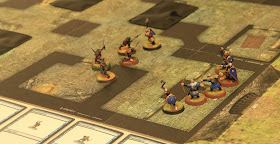These are the two bundles:
 |
| The Medieval Bundle: Peter Pig's Conquerors and Kings, Poleaxed 2nd Edition, Ed Smith's Wars of the Roses rules, and MiniFig's A Knight to Dismember rules. |
 |
| The Indian Mutiny Bundle: TVAG's John Company 2nd Edition, and The Devil's Wind. |
OK, this is the first time I am doing this and I am note sure if there are some internet rules about the whole thing, but these are the terms I offer.
Let me know if you are interested in getting either of the bundles by leaving a comment, and I will draw a recipient at the end of the month. This is not a first-come, first-serve offer.
The offer is free; once I let you know you have been drawn, do let me have your email and mailing address and I will mail it off to you. You don't even have to pay for the postage. I am doing this not to get some money back, but to give these rules a good home. If you want to pay back somehow, I ask that you make a small donation to a local charity, or consider doing the same thing I am doing and give some rulebooks that you no longer use a chance for a new lease of gaming life.
The Medieval Bundle is a straightforward, but the Indian Mutiny bundle is more... dubious. I understand that John Company is now in its 3rd Edition, and for some inexplicable reason I am missing the Event Cards sheets, so if you get it, you are getting an "obsolete" and "incomplete" game. In addition, it is also a thick book so postage will be higher, especially since there are also all those card sheets. If you want The Devil's Wind but not John Company 2, do indicate that in your comment/request and I will take that into account when deciding whom to send the Bundle to.
Thank you.




























